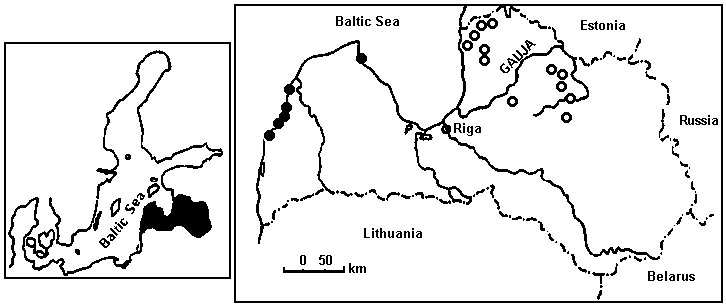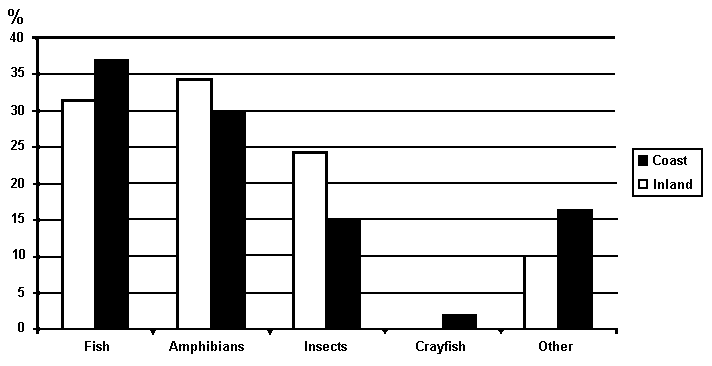 |
Last Update:
Thursday November 22, 2018
|
| [Home] |
|
Volume 15 Issue 2 Pages 68 - 127 (October 1998) Citation: Ozolins, J, Kranz, A & Toman, A (1998) Three Men In A Boat (To Say Nothing Of The Otter In Latvia). IUCN Otter Spec. Group Bull. 15(2): 103 - 108 Three Men In A Boat (To Say Nothing Of The Otter In Latvia)* Janis Ozolins1, Andreas Kranz2 and Ales Toman3 1State Forest Inventory Institute, Kristapa 30, LV - 1046 Riga, Latvia Received 12th June 1998, accepted 14th November, 1998
INTRODUCTION In the first half of this century, the otter Lutra lutra was regarded as 'nowhere numerous in Latvia but more common in the eastern part of the country than in the western' (LANGE, 1970). Latvian game statistics show a fairly evident decrease of otters from the 1920s until the 1940s, followed by a rapid increase after the Second World War (ORNICANS, 1996). Following the annexation of the country by the USSR, very little was known on an international scale about the status of the country«s otter populations. REUTHER (1980) mentioned that otters were rare in the whole East Baltic in the late 1970s. The first more detailed survey of otters in a Baltic country came from Estonia (LAANETU, 1989), who estimated the population to be 600 individuals, a comparatively low number for an area of 45.100 km2. The first investigations on otters in Latvia after the Second World War started in the 1980s. Initial evidences of an abundant population came from the legal bycatch of otters killed in beaver (Castor fiber) traps. 1.490 otters were killed in beaver traps over four consecutive hunting seasons in Latvia, in an area of 63.700 km2 (OZOLINS and RANTINS, 1994, 1995). Beaver hunting lasts from 1. October until 31. March, however, most beavers and also otters are caught in two months, October and November, before the rivers are covered by ice. Field surveys were also carried out between 1986 and 1991 (OZOLINS and RANTINS, 1992) and the minimal population was estimated to be 4,000 otters. In the 1990s, beaver hunting was no longer popular, because the fur price became too low and consequently only few otters are caught as a bycatch. This might cause an increase of otter numbers, but in Latvia fish densities are very low (BIRZAKS et al., 1998). This raises interest in the feeding peculiarities of otters in these habitats with few fish. Hence our 10 day field excursion had two main goals. Firstly, are there indications that otters increased in Latvia since the last survey, which was conducted 10 years ago. Secondly, what do otters eat in late summer, the season elsewhere in Europe dominated by fish as otter food. An additional question was to determine whether or not otters occur along the coast of the Baltic Sea and feed also in the marine environment. STUDY SITES, MATERIAL AND METHODS The Gauja is one of the main rivers of Latvia with a total length of 452 km. The investigated stretch - 23 km long and 91-68 km upstream of the estuary - is located within the Gauja National Park, though this did not mean a hunting ban on beavers. Here the river is about 70-100 m wide and on average 1.5 m deep. The flow is generally slow, but often interrupted by the presence of rapids. Bank side vegetation is trees, with areas of high sandstone cliffs. This stretch was investigated from a rowing boat on 6. and 7. September 1997, at the end of a long dry season which had resulted in a low water levels. Data from exactly the same stretch were available from an earlier survey in July 1988, but then the water level was higher (OZOLINS and RANTINS, 1992). Otter signs (spraints, tracks and sand heaps) were counted along 1 km river sections. In addition to the survey along the River Gauja, 237 spraints were collected from 12 small-medium sized inland streams, a further 26 were collected from the mouth of six small streams draining into the Baltic Sea (Fig. 1). The age of the spraints was from very fresh up to two weeks old (dry but still strong smelling) These were analysed and the results expressed as a relative frequency of occurrence. The length of eaten fish were estimated according to measurements of vertebrae (CONROY et al., 1993) or using measurements of other bones or scales in the reference collections (BIRZAKS et al., 1998).
RESULTS AND DISCUSSION In September 1997 many more signs (206 signs) were found along the 22 sections of river than in July 1988 (96 signs). These findings might be biased by more favourable weather conditions in September 1997 as well as a general seasonal increase of sprainting activity (KRANZ, 1996). It should be noted that the number of spraints alone is a problematic parameter for indicating the status of a population (CONROY and FRENCH, 1987; MASON and MACDONALD, 1987; KRUUK et al., 1986), however, the fact that during the 1997 survey otters occurred along almost all waterbodies, including ditches and small streams throughout the country, and even on isolated less than 3 m wide creeks draining into the Baltic Sea, indicates a thriving population. This omnipresence of otters is obviously the result of a sufficient population to push otters also into small isolated streams and ditches and indicates rather a stable or increasing otter population than a decreasing one. However, more systematic investigations would be necessary to really prove an increase of the otter population after hunting ceased. The Baltic Sea obviously does not hold an otter population on its own, because no tracks and spraints could be found except from estuaries of small creeks and even there spraints did not contain many saline fish species. Along the coast of Kurland, between the Lithuanian border and Riga, otters were found at six of seven estuaries visited, but only 6.5% of the prey items found in 26 spraints belonged to saline species, mainly Zoares viviparus. The Baltic Sea is very shallow and sandy there, which might be unfavourable for fish in the littoral zone and in particular for otters predating these fish. Coastal otters are more commonly associated with rocky or gravel coast, frequently with kelp forests, which provide cover for fish (KRUUK, 1995). Similar observations come from the Lake Baikal, where otters avoid sandy beaches (KRANZ et al., 1995) and the same is true along the Costa Brava in eastern Spain, where otters were reintroduced (RUIZ-OLMO, pers. com.)
Along the inland streams, the late summer diet of otters (Fig. 2) was only to 37% fish. Amphibians accounted for 30%; insects (mainly Dytiscus sp., terrestrial Coleoptera and Odonata) 15%; mammals 4%; birds 4%; molluscs 2.2% (spraints contained whole shells or fragments and covers of cover-holding snails (Viviparidae); plants 5.8% and crayfish 2%. The situation along the coast was similar, but more insects and amphibians were recorded; no crayfish or crabs were found. Almost 90% of the fish (n = 501) were less than 10 cm (Tab. 1). The strong prevalence of non-fish prey, especially in late summer contrasts with findings elsewhere in Europe. In most habitats throughout Europe fish dominate the diet of otters, e.g. in Sweden (ERLINGE, 1967), in Hungary (KEMENES and NECHAY, 1990), in the Pyreneas (RUIZ-OLMO et al., 1989) or in Ireland (KYNE et al., 1989). Only in spring can amphibians form an important part of the diet (WEBER, 1990). Actively consumed insects, as it was definitely the case here in Latvia, were nowhere recorded in such quantities. It is only in the geographically near eastern Poland (BRZEZINSKI et al., 1993) resembles our findings. They contradict the statement that insects and amphibians increase in otter spraints as latitude decreases (ADRIAN and DELIBES, 1987). Indeed not only in late August and early September but throughout the year (BIRZAKS et al., 1998) non-fish prey is dominant in the diet of Latvian otters. The low abundance of fish in the small and medium-sized streams fits well to these findings. Big rivers, lakes and large beaver ponds are more rich in fish (OZOLINS and RANTINS, 1992), but they make only a small fraction of otter habitat in the Eastern Baltic. Hence, Latvia might provide an example that otters can thrive even when fish are scare, given that other prey species are abundant. ACKNOWLEDGEMENTS - We are very grateful to two anonymous reviewers for their comments, which improved both, the style and the content. REFERENCES Adrian, M. I. & Delibes, M. (1987). Food habits of the otter (Lutra lutra) in two habitats of the Donana National Park, SW Spain. J. Zool. 212: 399-406. Resúmen: Tres hombres en un bote (decir nada sobre las nutrias en Latvia) |
| [Copyright © 2006 - 2050 IUCN/SSC OSG] | [Home] | [Contact Us] |

